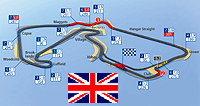- Home
-
News
-
Latest News
- Japanese Grand Prix: Preview - Mercedes
- Japanese Grand Prix: Preview - Aston Martin
- Aston Martin name will continue in F1, insists Stroll
- Japanese Grand Prix: Preview - Red Bull
- Japanese Grand Prix: Preview - Alpine
- Red Bull reveals Honda tribute livery for Suzuka
- Former Alpine protege Martins joins Williams
- Japanese Grand Prix: Preview - McLaren
- Japanese Grand Prix: Preview - Pirelli
- More News
-
-
Drivers
-
Current Drivers
- Max Verstappen
- Lando Norris
- Gabriel Bortoleto
- Isack Hadjar
- Jack Doohan
- Pierre Gasly
- Andrea Kimi Antonelli
- Fernando Alonso
- Charles Leclerc
- Lance Stroll
- Yuki Tsunoda
- Alexander Albon
- Nico Hulkenberg
- Liam Lawson
- Esteban Ocon
- Lewis Hamilton
- Carlos Sainz
- George Russell
- Oscar Piastri
- Oliver Bearman
- Test/Reserve Drivers
-
- Teams
-
Tracks
-
Current Circuits
- Melbourne (Australia)
- Shanghai (China)
- Suzuka (Japan)
- Sakhir (Bahrain)
- Jeddah (Saudi Arabia)
- Miami (USA)
- Imola (Italy)
- Monte Carlo (Monaco)
- Barcelona (Spain)
- Montreal (Canada)
- Red Bull Ring (Austria)
- Silverstone (UK)
- Spa-Francorchamps (Belgium)
- Budapest (Hungary)
- Zandvoort (Netherlands)
- Monza (Italy)
- Baku (Azerbaijan)
- Singapore (Singapore)
- Austin (USA)
- Mexico City (Mexico)
- Interlagos (Brazil)
- Las Vegas (USA)
- Losail (Qatar)
- Abu Dhabi (UAE)
-
- Seasons
-
Pictures
-
Latest Galleries
- 2025 Chinese GP
- 2025 China Saturday
- 2025 China Friday
- 2025 Australian GP
- 2025 Australia Saturday
- 2025 Australia Practice
- 2025 Bahrain Pre-Season Test 28 Feb
- 2025 Bahrain Pre-Season Test 27 Feb
- 2025 Bahrain Pre-Season Test 26 Feb
- 2025 Launch - Williams FW47
-
Gallery Categories
- 2025 Season
- 2024 Season
- 2023 Season
- All galleries
-
- Stats
- JOHNNYBET























